Idaho Army National Guard conducts 8th search and rescue mission of 2025

An Idaho Army National Guard helicopter crew from Detachment 1, Golf Company, 1st Battalion, 168th Aviation Regiment executed the IDARNG Aviation Group’s eighth successful search and rescue mission of 2025 on Wednesday. The unit responded with an HH-60M Black Hawk and crew to a request from Air St. Luke’s for a helicopter with hoist capability. The Air St. Luke’s aircrew had located the patient, a 55-year-old male with a broken leg on a ridgeline near Fiddle Lake on Trinity Mountain east of Boise.
An initial assessment indicated that no suitable landing zone was available near the patient. However, by the time the HH-60 crew arrived on scene, the Air St. Luke’s team had located a suitable LZ, landed and hiked to the patient to assess him and provide first aid.
Sgt. First Class Jade Parsons, the crew’s senior flight medic, was hoisted down and made contact with the Air St. Luke’s team at the patient’s location. After conferring, the joint team determined that with the landing zone and additional manpower, the patient could now be carried by litter from the point of injury to the Air St. Luke’s helicopter. Working together, the Air St. Luke’s and Army National Guard crew members carried the patient by litter to the landing zone and loaded him into the Air St. Luke’s helicopter. However, due to power limitations of their helicopter, the Air St. Luke’s crew was unable to safely evacuate the patient’s dog and gear along with him.
Parsons and Staff Sgt. Jake Brown – the second Army medic on the mission – improvised a muzzle and makeshift hearing protection for the dog before loading him and the patient’s gear into the Black Hawk. The Soldiers then safely delivered the dog and gear to a Fairfield ambulance that was on standby about a mile away.
“In the National Guard, we’re also trained in canine medicine, so we know how to sedate, protect and transport them,” said Parsons.
In this case, the dog was friendly and did not require sedation to board the Black Hawk and fly to safety.
“He was really good,” said Parsons. “When we got him to the ambulance and he got the muzzle off, he turned around and smiled at us.”
Idaho Bureau of Emergency Medical Services joins Idaho Military Division

The Idaho Military Division is excited to welcome the state’s Bureau of Emergency Medical Services into the organization. This transition, effective July 1, 2025, marks a significant step toward enhancing Idaho’s emergency response capabilities and building a more resilient state.
As the state’s coordinating body for emergency management through IOEM, the division brings decades of experience in disaster preparedness, coordination and community support. The integration of EMS creates new opportunities for innovation, collaboration and expanded service.
“This transition presents IMD with an opportunity to use our knowledge and build upon our expertise while continuing to serve Idahoans through expanded capabilities that enhance our commitment to public safety,” said Adjutant General of Idaho Maj. Gen. Tim Donnellan. “We’re excited to welcome EMS into IMD and look forward to the incredible impact we can make together for communities across the state.”
The EMS Bureau supports a range of critical programs, including EMS systems and licensing, State Communications and the Time Sensitive Emergency program. While EMS delivery varies across Idaho, this move brings renewed focus and coordination to address system-wide challenges such as staffing and long-term sustainability.
EMS operations will relocate to Gowen Field in Boise, further aligning daily coordination with state emergency functions and reinforcing Idaho’s unified approach to public safety. StateComm will continue operations from its current location in Meridian.
Additionally, increased grant funding has been authorized for nonprofit and governmental 911 response agencies to support personnel and operational needs, an important step toward strengthening EMS at the local level.
“Across a large and geographically diverse state like Idaho, timely response and efficient coordination are important to saving lives,” said EMS Bureau Chief Wayne Denny. “This transition will help maintain and continue to improve strong partnerships with healthcare providers, emergency responders and public health professionals across the state.”
House Bill 206, introduced in the House Transportation and Defense Committee, passed both chambers with majority support during the 2025 legislative session. The legislation directed the move of EMS from IDHW to IMD.
IMD is working closely with EMS leadership, the Governor’s Office, the Idaho Department of Health and Welfare and other partners to support a smooth transition.
The Idaho Military Division remains fully committed to the bureau’s mission: to reduce disease, injury and death through prevention, awareness and quality service. By aligning resources and expertise under one roof, this transition enhances Idaho’s ability to protect the health and safety of its residents today and into the future.
For media inquiries regarding this news release, please contact EMS Bureau Chief Wayne Denny at Wayne.Denny@dhw.idaho.gov or 208-334-4000.
Leaning Forward: Idaho National Guard Forges Cyber Defense Through Realistic Training

In an era where threats are just as likely to be identified in cyberspace as on the battlefield, the Idaho National Guard is redefining what it means to protect and defend. Through exercises like Cyber Discovery, the Guard is not only training its members to respond to cyber threats but also forging critical partnerships with state agencies, educational institutions and fellow military units from across the country.
Soldiers from the Idaho Army National Guard, South Dakota Army National Guard and Alaska National Guard joined with civilian experts from Saint Luke’s, Boise State University and the City of Nampa to conduct Cyber Discovery 2025 May 16 to June 12. The exercise was hosted by the State of Idaho Office of Information Technology Services at the state’s Chinden Campus in Boise.
“Cyber Discovery is essentially a joint cyber exercise where the military division and executive branches of Idaho come together,” said Warrant Officer 1 Seth Gaskins, a member of the Idaho Army National Guard and one of the key figures behind the collaborative exercise. “It’s an annual training event designed to stress test the state’s cyber capabilities while helping Airmen and Soldiers improve their skill sets on offensive cyber capabilities.”
Unlike many training events that rely on controlled, simulated environments, Cyber Discovery pushes participants into a more realistic digital battlefield, according to Gaskins.
“Cyber Shield is a great event but it’s largely simulated,” said Gaskins, referencing a well known national cyber exercise. “Cyber Discovery is different. It uses real networks and real-world vulnerabilities. It’s dynamic. There’s someone on the other side pushing back in real time.”
This year’s exercise pitted a “red team” simulating a coordinated cyber attack by a foreign adversary against a “blue team” tasked with detecting the threat and executing a incident response plan. The scenario offers Airmen and Soldiers a rare opportunity to train in a highly realistic, high-pressure environment that closely mirrors the challenges of real-world cyber warfare.
“Real world events happen every day, just because we don’t hear about it, does not mean it’s not being dealt with,” said Gaskins. “Cyber Discovery is used as a controlled live threat that simulates real world actions.”
Cyber Discovery is just one of several cyber exercises the Idaho National Guard engages in. Gaskins also leads monthly outreach missions where state organizations invite his team to identify and assess potential vulnerabilities in their systems. These collaborative efforts not only provide a valuable stress test for the organizations’ cyber defenses but also gives Guard members critical hands-on experience in real world environments.
As cyber threats continue to evolve in complexity and scale, the Idaho National Guard remains committed to staying ahead of the curve by training its personnel on the front lines of digital defense and building lasting partnerships that strengthen the state’s cyber resilience. In Idaho, the fight to secure cyberspace is already underway and the Idaho National Guard is leading the way forward.
State Aviation Group trains with Boise Fire Department
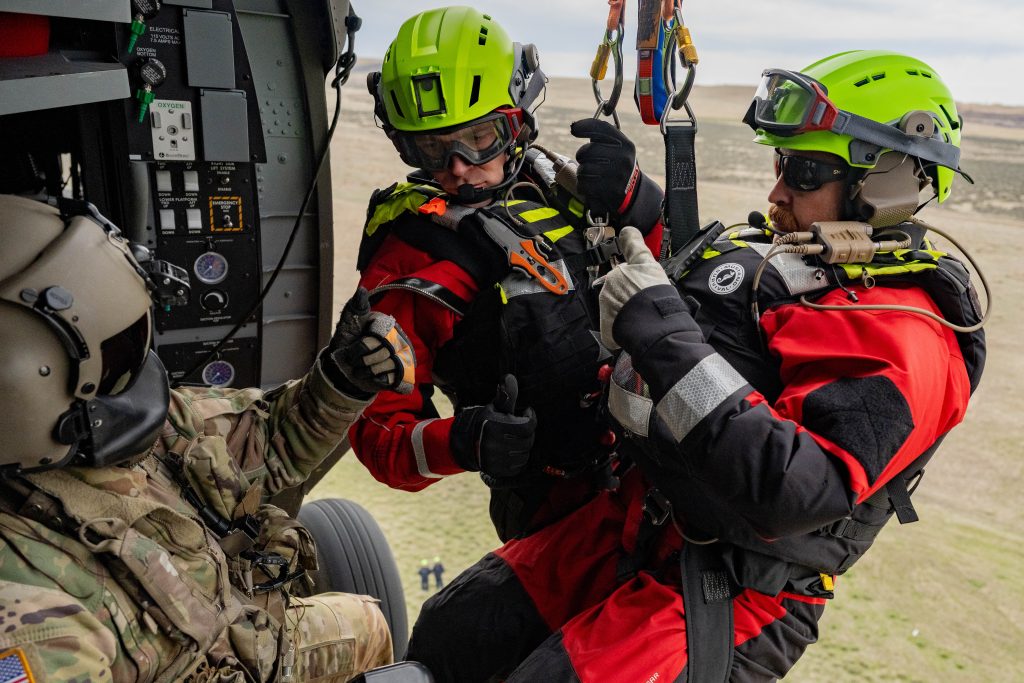
OCTC hosts 17th Field Artillery Brigade for HIMARS training
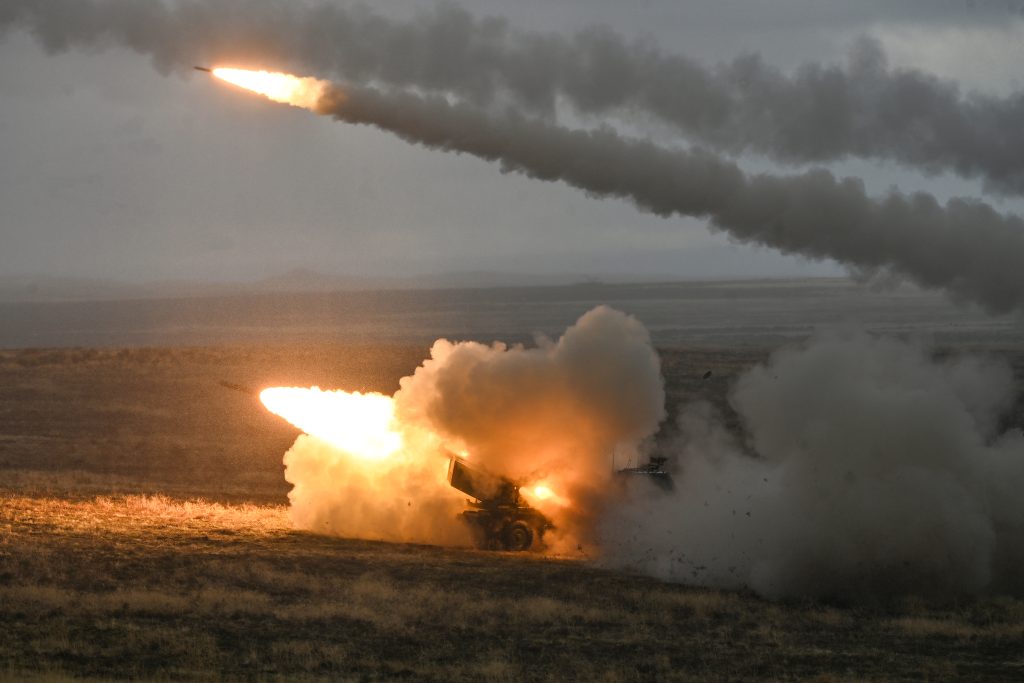
Idaho National Guard mobilizes 350 Guardsmen for Presidential Inauguration 60
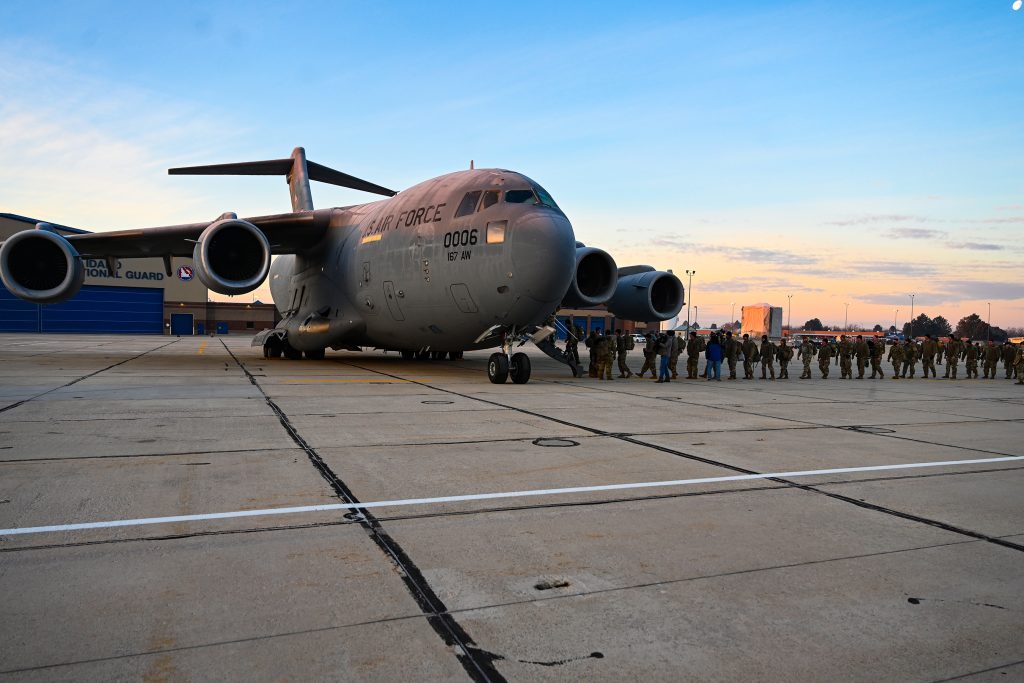
The Idaho National Guard mobilized approximately 350 Soldiers and Airmen to Washington, D.C. Jan. 17 to assist district and federal agencies with the 60th Presidential Inauguration.
“I am incredibly proud of the men and women of the Idaho National Guard as they mobilize to support civil authorities during the 60th Presidential Inauguration in Washington, D.C.,” said Maj. Gen. Tim Donnellan, adjutant general of Idaho and commander of the Idaho National Guard. “Their professionalism, dedication and unwavering commitment to our nation exemplify the very best of our state and our military tradition. I have full confidence in their ability to represent Idaho with honor and ensure the safety and security of this historic event.”
Idaho is one of approximately 40 National Guard states supporting the peaceful transfer of power between President Joe Biden and President-elect Donald J. Trump Jan. 20.
Guardsmen will augment the Washington D.C. National Guard and serve in support of the U.S. Secret Service, the lead federal agency responsible for coordinating the event, and assist the U.S. Capitol Police. Guardsmen will assist with crowd management, traffic control, emergency response services and other critical tasks necessary for the event’s success.
Idaho’s citizen-Soldiers and Airmen will return to Idaho following the inauguration.
The National Guard’s predecessors supported George Washington’s first inauguration and the National Guard has supported every inauguration since Abraham Lincoln’s in 1861. This mobilization maintains this tradition. More recently, the Idaho National Guard supported the 59th Presidential Inauguration in a similar role in 2021.
The Idaho National Guard also deployed a UH-60 Black Hawk company to Fort Belvoir, Virginia, last week for an unrelated year-long mission supporting the Joint Emergency Evacuation Plan in the National Capital Region, a routine rotational mission performed by National Guard units in support of the U.S Army.
Helicopter company deploys to National Capital Region
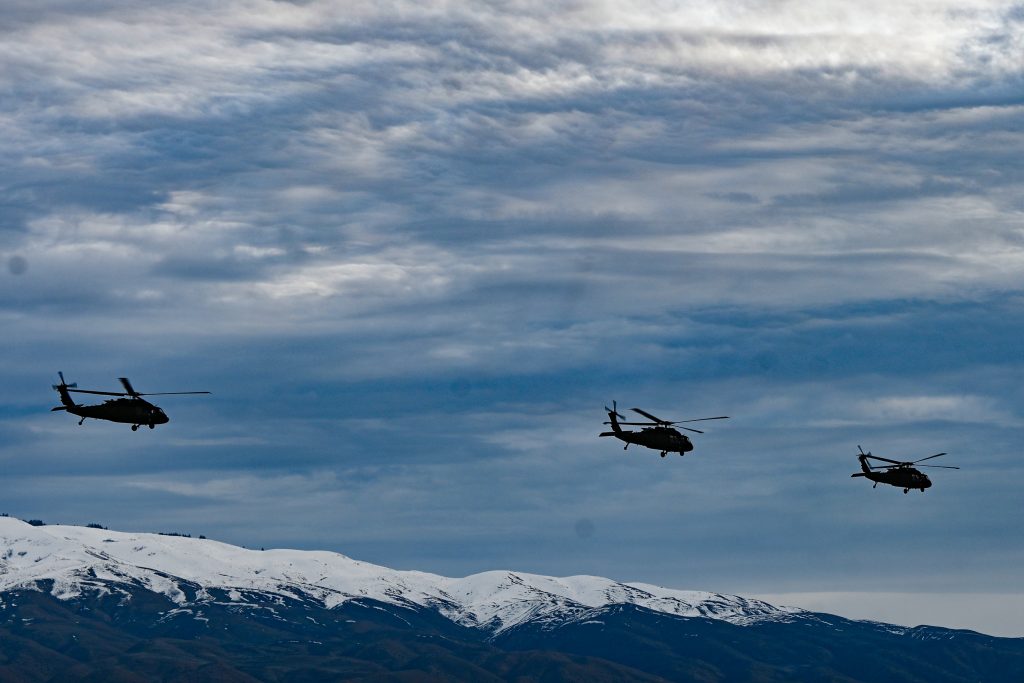
The Idaho National Guard deployed 10 UH-60 Black Hawk helicopters and more than 80 Soldiers to Ft. Belvoir, Virginia Jan. 10 and 11 on a year-long deployment in support of the Joint Emergency Evacuation Plan mission. Soldiers from the Idaho National Guard’s Company B, 1-183rd Assault Helicopter Battalion bid farewell to family and friends during a departure ceremony at Gowen Field Jan. 9.
“This mission is vital to the safety and security of our nation, and I truly believe each of you are the most valuable asset that we are taking with us,” said Capt. Eric Fitzpatrick, B Co. commander. “Each of you has been trained to meet the challenges that you are about to face, and I believe you are the backbone of this mission.”
Maj. Gen. Tim Donnellan, commander of the Idaho National Guard, was on hand to wish the Soldiers farewell and remind family members of resources available to them should they need them.
“All the hard work, all the training that you have done will satisfy the requirements for this incredible federal mission,” said Donnellan. “I’m very proud that, once again, Idaho is stepping up and we are answering the call, and we are doing what we said we would do. We will be ready, and we will be relevant when asked to do these missions.”
The JEEP is a recurring mission shared by National Guard and active-duty units from across the nation. 1-183rd AHB will provide airlift capabilities to official personnel in the Capital Region.
U.S. Special Forces, Indian Army bring Vajra Prahar to Idaho
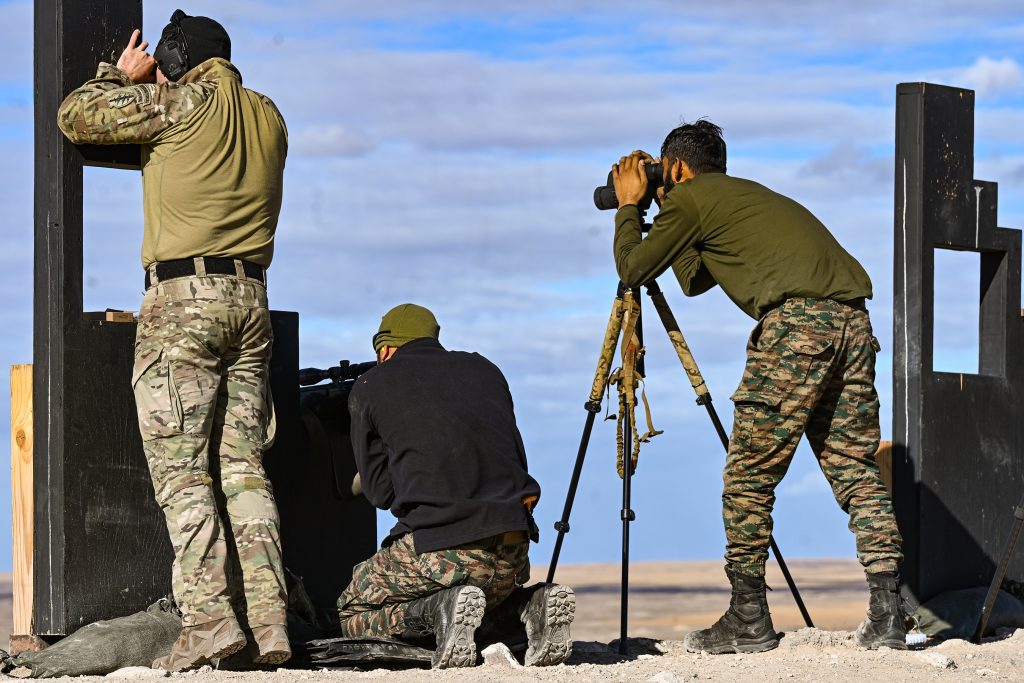
The U.S. Army’s 1st Special Forces Group (Airborne), along with partners from the Indian Army’s Special Operations Forces and the Idaho National Guard’s 124th Air Support Operations Squadron participated in Exercise Vajra Prahar Nov. 2 through 22 on Orchard Combat Training Center ranges and facilities. The exercise is designed to enhance cooperative relationships between the elite units, focusing on realistic training scenarios that challenge participants in complex environments.
The 124th ASOS was tasked to provide the Indian soldiers with Joint Terminal Attack Controller and close air support instruction to enhance interoperability between Indian and U.S. special operations forces.
“We helped build stronger relationships with the partner force by demonstrating the Tactical Air Control Party’s commitment to their success and providing them with valuable training and resources,” said Master Sgt. Douglas K. Brock, a JTAC with 124th ASOS. “In the end, the 124th ASOS showcased their ability to work with anyone, anywhere, at any time to achieve mission success by maintaining a high level of readiness, while also building a foundation for future training and development opportunities.”
Vajra Prahar is an annual exercise, now in its 15th year, and changes locations annually between U.S. and Indian training facilities to improve the special operators’ ability to work together in a variety of terrain and climate combinations. This is the first time the exercise has taken place in Idaho.
“The airspace and training facilities have been awesome at the OCTC,” said a member of 1st SFG(A). “They’ve given us the ability to run CH-47 Chinook missions, live talk on JTAC training, conduct sniper training and make direct-action assaults on multiple urban objectives.”
The combination of the realistic training environment and integration of skillsets from each of the participating units fostered tactical improvements and stronger relationships among the partner-nation forces, according to the 1st SFG(A) Soldier.
“By engaging in this rigorous training, participants develop their skills improve communication and foster a spirit of collaboration that is essential for successful operations in real-world situations,” he said. “Working alongside our partners across the Indo-Pacific region increases security capacity and interoperability among our forces.”
The OCTC, a 173,000-acre training center is a premier joint combined arms training site located 18 miles south of Boise, provides world-class training facilities for war fighters from all U.S. Armed Forces and partner nations from around the globe.
Idaho Army National Guard Names Honorary Unit Commanders
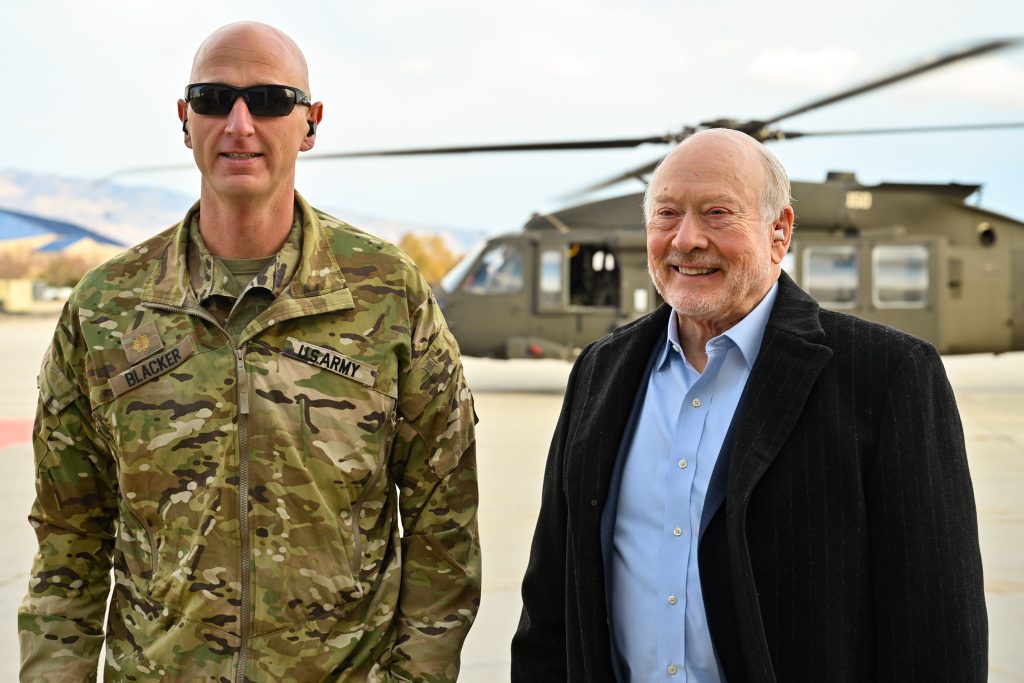
The Idaho Army National Guard welcomed 10 new honorary unit commanders to its ranks Friday. Honorary commanders are selected from among business, education and civic leaders to participate based on their desire to gain increased awareness and understanding of the Idaho Army National Guard’s mission, policies and programs.
“Our Honorary Unit Commander Program is a vital bridge between our Guardsmen and the communities we proudly serve,” said Brig. Gen. Cole Packwood, commander of the Idaho Army National Guard. “This program fosters a deeper understanding of our mission and provides an opportunity for community leaders to experience firsthand the dedication of our Soldiers.”
The honorary commanders received a history and capabilities brief and tour which included opportunities to interact with National Guardsmen and learn more about equipment like Bradley Fighting Vehicles, Abrams tanks and Black Hawk helicopters.
Six of the honorary commanders will serve with units headquartered at Gowen Field in Boise. Dr. Paul Bennion, the vice president for student affairs and dean of students at College of Idaho, will serve with the Idaho Army National Guard Training Center. West Ada School District’s superintendent of school Derek Bub will serve with the 116th Cavalry Brigade Combat Team. Debbie Critchfield, the Idaho Department of Education’s superintendent of public instruction, will serve with the Idaho Army Guard’s Recruiting and Retention branch. FBI Special Agent Dan Ramirez will serve with the 101st Civil Support Team. Bill Waterman, the assistant director of athletic bands at Boise State University, will serve with the 25th Army Band. Current Idaho State Sen. Charles Winder will serve with the 204th Regional Training Institute.
In other parts of the state, Pastor Dave Bruyette of Mountain Lakes Bible Church will serve with the 145th Brigade Support Battalion, which is located in northern Idaho and headquartered in Lewiston. City of Jerome Mayor David Davis will serve with the 116th Brigade Engineer Battalion, which is headquartered in Twin Falls. Frank VanderSloot of Melaleuca, Inc. will serve with the 1-148th Field Artillery Regiment, located in eastern Idaho and headquartered in Pocatello. Greg Wiles, superintendent of Nampa Christian Schools, will serve with the 2-116th Cavalry Regiment, which is headquartered in Caldwell.
The Honorary Unit Commander Program educates key community leaders about the Idaho Army National Guard’s mission and to foster a partnership with the community. Throughout their tenure, they will work closely with their assigned unit commanders and staff and be invited to participate in unit ceremonies and observe selected training events.
“These partnerships enhance the connection between our organization and the public, reinforcing our role as a trusted and integrated force in Idaho and beyond,” said Packwood.
The Idaho Army National Guard is headquartered on Gowen Field in Boise and consists of nearly 3,000 Soldiers. Its largest unit is the 116th Cavalry Brigade, with armories in nearly two dozen Idaho communities and battalions in Montana, Nevada and Oregon. The 1-148th Field Artillery Regiment, 116th Brigade Engineer Battalion, 145th Brigade Support Battalion and 2-116 Cavalry Regiment are four of the 116th Cavalry Brigade Combat Team’s seven battalions. The 1-183rd Aviation Regiment, located in Boise, completes the majority of the Idaho Army National Guard’s combat power.
First HH-60M Black Hawk Arrives at Gowen Field
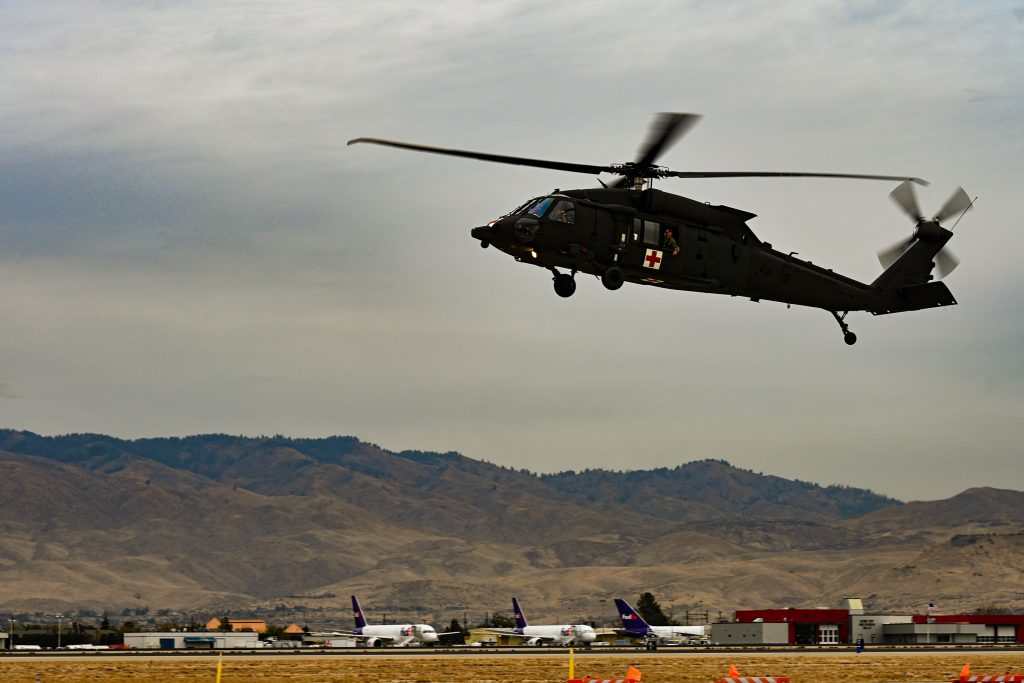
The next phase in Idaho Army National Guard modernization efforts began Oct. 23 with the arrival of a new HH-60M Black Hawk helicopter at Gowen Field. It is the first of six expected to be delivered over the next six to eight months.
The HH-60M is the medical evacuation version of the UH-60M Black Hawk and will replace the Idaho Army National Guard’s fleet of UH-60L helicopters, which frequently support local and state agency search and rescue missions. The Idaho Army National Guard completed the upgrade of its utility helicopter fleet to the UH-60M in 2022.
“Upgrading our MEDEVAC helicopters to the M model is more than an investment in equipment—it’s an investment in our Soldiers,” said Idaho Army National Guard Commander Brig. Gen. Cole Packwood. “With enhanced medical capabilities coupled with improved and advanced flight controls, these helicopters are mission-critical assets that directly impact our ability to save lives, ensuring that we meet the mission with speed, capability and the highest standards of care possible. Our troops deserve nothing less.”
The new MEDEVAC helicopter includes all upgrades included in the UH-60M with the addition of improved cabin configuration and integrated medical capabilities not present in the UH-60L models. These capabilities include an onboard oxygen generation system, medical suction, electrical outlets that can be used to power specialized medical equipment, and an environmental control system that can be used to help stabilize patients suffering from heat or cold injuries.
Changes to the HH-60M airframe and interior will also result in increased proficiency whether during combat operations abroad or search and rescue missions closer to home, according to Chief Warrant Officer 4 John Jacobs, the production control officer for the 1-183rd Aviation Battalion. One such improvement is integration of the rescue hoist mount to the airframe.
“This will reduce drag, allowing us to fly faster or use less fuel,” said Jacobs. “In either case it allows us more loiter time on site to conduct operations.”
The forward interior of the new Blackhawk boasts an electric litter lift, improving capacity to up to six littered or seated patients in addition to the hoist operator and medic seats, which have been moved to the rear of the interior to increase the mobility and effectiveness of those personnel. A hoist operator-controlled search light has also been added to the undercarriage, enabling that Soldier to spotlight injured personnel or lost hikers for rescuers. Additionally, the forward-looking infrared camera has been moved to the helicopter’s nose for a more unobstructed view and its images can be shown directly on the pilot’s multi-function display.
As the new helicopters arrive at Gowen Field, its UH-60L MEDEVAC fleet is being fielded to other area Army National Guard units, extending the capabilities of those units while stretching the taxpayer dollar to the maximum extent possible, according to Jacobs.
“We’re very lucky to have a young and modern fleet,” he said.
 Official Government Website
Official Government Website